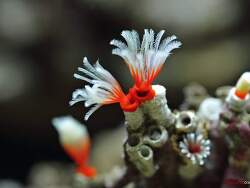Info
Tubeworm with bright red feathers that gradually pale towards the ends. The feathers extend from thin white and grouped calcareous tubes.
The feathers are 2.5cm in size. in diameter, the tubes can become much longer. This species and many other tubeworms are very sensitive to changes in light. If you approach it too quickly or abruptly, it will very quickly retreat into its living tube.
These tubeworms attach to hard substrates such as rocks and boulders, but can also be found in harbors and pier pilings, on overhangs, and under coral heads, starting at 5 m and extending to greater depths, well beyond the dive limit.
Tubeworms are filter feeders. If the tubeworm colony is fed regularly with dust food for filter feeders, one can try to maintain it.s.
The feathers are 2.5cm in size. in diameter, the tubes can become much longer. This species and many other tubeworms are very sensitive to changes in light. If you approach it too quickly or abruptly, it will very quickly retreat into its living tube.
These tubeworms attach to hard substrates such as rocks and boulders, but can also be found in harbors and pier pilings, on overhangs, and under coral heads, starting at 5 m and extending to greater depths, well beyond the dive limit.
Tubeworms are filter feeders. If the tubeworm colony is fed regularly with dust food for filter feeders, one can try to maintain it.s.







 BioTaucher
BioTaucher










